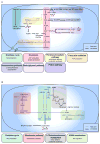Endothelial cell metabolism in normal and diseased vasculature
- PMID: 25814684
- PMCID: PMC4380230
- DOI: 10.1161/CIRCRESAHA.116.302855
Endothelial cell metabolism in normal and diseased vasculature
Abstract
Higher organisms rely on a closed cardiovascular circulatory system with blood vessels supplying vital nutrients and oxygen to distant tissues. Not surprisingly, vascular pathologies rank among the most life-threatening diseases. At the crux of most of these vascular pathologies are (dysfunctional) endothelial cells (ECs), the cells lining the blood vessel lumen. ECs display the remarkable capability to switch rapidly from a quiescent state to a highly migratory and proliferative state during vessel sprouting. This angiogenic switch has long been considered to be dictated by angiogenic growth factors (eg, vascular endothelial growth factor) and other signals (eg, Notch) alone, but recent findings show that it is also driven by a metabolic switch in ECs. Furthermore, these changes in metabolism may even override signals inducing vessel sprouting. Here, we review how EC metabolism differs between the normal and dysfunctional/diseased vasculature and how it relates to or affects the metabolism of other cell types contributing to the pathology. We focus on the biology of ECs in tumor blood vessel and diabetic ECs in atherosclerosis as examples of the role of endothelial metabolism in key pathological processes. Finally, current as well as unexplored EC metabolism-centric therapeutic avenues are discussed.
Keywords: angiogenesis; atherosclerosis; cancer; diabetes mellitus; endothelial metabolism.
© 2015 American Heart Association, Inc.
Figures



References
-
- Tammela T, Alitalo K. Lymphangiogenesis: Molecular mechanisms and future promise. Cell. 2010;140:460–476. - PubMed
-
- Potente M, Gerhardt H, Carmeliet P. Basic and therapeutic aspects of angiogenesis. Cell. 2011;146:873–887. - PubMed
-
- Mazzone M, Dettori D, Leite de Oliveira R, Loges S, Schmidt T, Jonckx B, Tian YM, Lanahan AA, Pollard P, Ruiz de Almodovar C, De Smet F, Vinckier S, Aragones J, Debackere K, Luttun A, Wyns S, Jordan B, Pisacane A, Gallez B, Lampugnani MG, Dejana E, Simons M, Ratcliffe P, Maxwell P, Carmeliet P. Heterozygous deficiency of phd2 restores tumor oxygenation and inhibits metastasis via endothelial normalization. Cell. 2009;136:839–851. - PMC - PubMed
-
- Phng LK, Gerhardt H. Angiogenesis: A team effort coordinated by notch. Developmental cell. 2009;16:196–208. - PubMed
Publication types
MeSH terms
Substances
Grants and funding
LinkOut - more resources
Full Text Sources
Other Literature Sources
Medical

